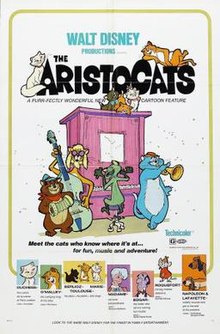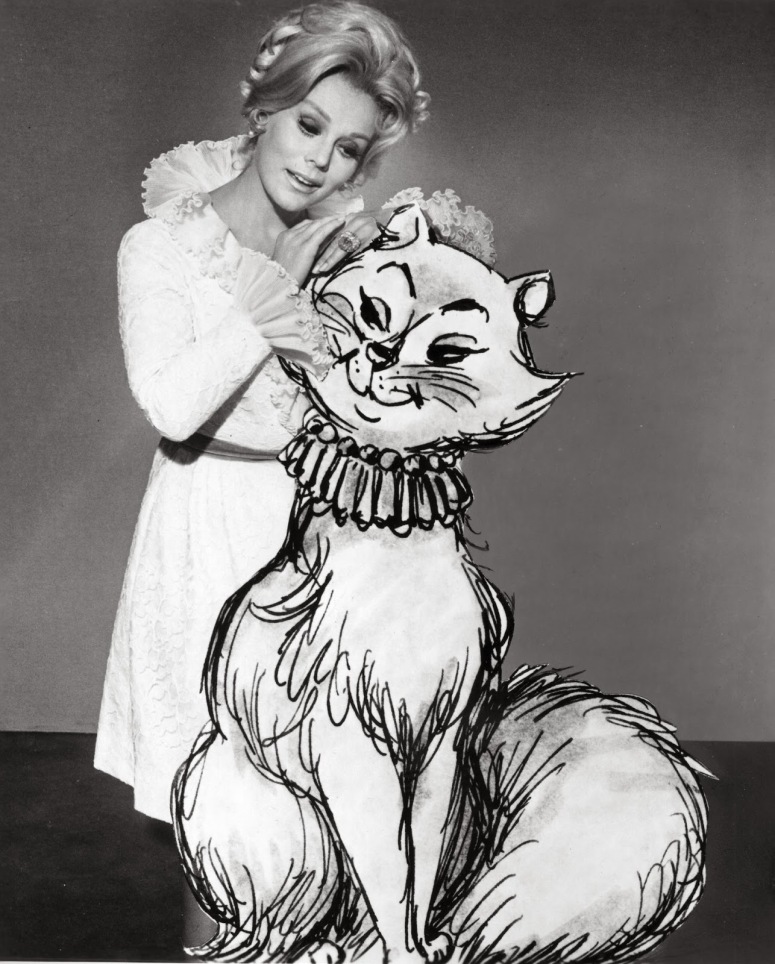
The film was actually proposed as a live action, two parter for television on Walt Disney’s Wonderful World of Colour.[1] Work on the idea began in 1961 when Harry Tytle and Tom McGowan were challenged to develop an animal story for the screen.[2] By the New Year, several stories had been suggested, including one about a mother cat and her kittens in New York.[3] The location was changed to Paris to play upon the succession that One Hundred and One Dalmatians had with its location being in London.[4]
The initial script was sent to the animation studios in August 1962, however it was rejected.[5] Undeterred by this failure, Tytle had faith within the project and sent the script directly to Walt who was staying in London at the time.[6] Disney approved this draft after crucially suggesting some improvements to the story.[7]
The first mention of the project being turned into an animated feature arose in 1963.[8] As a result of this change in direction, the project was put on hold as the animation studio were already well underway with the Jungle Book.[9]
Extracts from Tytle’s diary on the 25th 1964 allow us an intimate look into the developments that Walt discussed during his life time. Tytle says how Walt:
‘felt the Aristocats should follow the same tack as Dalamatians. He said it would be good if the cats could talk amongst themselves, but never in front of humans.’[10]
‘We discussed Waterloo (one of the kittens) and some of the earlier business that Walt had cut out. We have to stay to (just) three kittens, as there is too much business in the original treatment’[11]
We will see how some of these decisions will go on to influence the final story, continuing to have influence throughout of the whole of the film’s production.
The film’s script was sent to several of Disney’s personal employees, including studio nurse Hazel George.[12] The preliminary script receive praised from those who read it.[13]
The concept of the story around this period was that Duchess, a mother of three kittens called Berlioz, Marie and Toulouse, was searching for the perfect home where her kittens could be loved and their talents could thrive.[14] This was because there was a butler and a maid who were meant to be the inheritors of their mistresses’ fortune, however their placed was bumped down in favour of the cats.[15] So Duchess had to ensure the safety of her kittens.
However, this slow but gradual progression with the story was halted by the death of Disney himself in December 1966. Production on films did continue, but there seems to have been an air of doubt as to the future of the animation studios, even the company itself. It is within this turbulent time we see the film The Aristocats change from its existing form into the picture we see on screen today.[16]
Woolie Reitherman, one of the nine old men, took over as director for the film.[17] He wanted to take the film on a similar path to One Hundred and One Dalmatians.[18] Now this is not too dissimilar to some of Walt’s ideas that Tytle had noted down. However, Reitherman was not too keen on the more ‘mushy’ story line of a mother’s self-sacrifice for her kittens.[19] His take on ‘making the film more like One Hundred and One Dalamatians was more to do with action and comedy, and not the feel of the world as Walt was alluding to.[20]
Now, one may consider Reitherman’s changes to be rash. After all, Disney’s input had so often changed and expanded upon the story and character development, not to mention indirectly affecting box office revenue through his involvement. However we need to remember that Walt was not here anymore and the studio was once again going through an uncertain period – not necessarily financially – but creatively. The Aristocats needed to be a success in order to justify to the new bosses of the animation studio’s validity and attractiveness for investment.[21] Reitherman had the unenviable task of having to slim down the story (through cutting the number of villains and streamlining the plot), in order to keep costs down and thus ease production.[22] All this was in the hope that it was make a profit at the box office and cement the status of the animation studios.
As part of Reitherman’s cost and time cutting measures, the designs off the characters were significantly changed.[23] Thomas O Malley had originally been a tabby cat but this was changed to the easier to draw and ink, plain orange and white cat.[24]



The Aristocrats was released on the 11th December 1970 and took $10.1 by the end of 1971.[33] The reviews were on the same positive line as the favourable profits from the box office with the New York Times saying that it was ‘grand fun all the way’.[34] Ultimately, because of this achievement, the new managers of the Walt Disney company put their faith within the animation department, giving the go ahead for several more films that would take the studios up to the close of the decades.[35]
7 Facts for 7 dwarves
- Some of the animation for Duchess was reused for Maid Marian in Robin Hood.[36]
- Louis Armstrong was meant to be the voice of Scat Cat.[37]
- Armstrong was ill and so was unable to commit to the role.[38]
- There was meant to be four kitten, the other one called Waterloo.[39]
- There was meant to be an Aristocats II but this was scrapped.[40]
- Robie Lester, the singing voice of Duchess, went on to narrate the Read Along version of the film.[41]
- This was the last film to finish with Walt Disney Production.[42]
Bibliography
- Conradt, Stacy, 14 Fun Facts about the Aristocats,<http://mentalfloss.com/article/60868/14-fun-facts-about-aristocats>, [accessed 29/12/2018]
- Deja, Andreas, ‘Milt’s Aristocats Drawings’, Deja View, <http://andreasdeja.blogspot.com/2016/06/milts-aristocats-drawings.html>, [accessed 19/04/2019]
- Deja, Andreas, ‘Aristocats’, Deja View, <http://andreasdeja.blogspot.com/2011/08/aristocats.html>, [accessed 19/04/2019]
- Deja, Andreas, ‘Duchess’, Deja View, <http://andreasdeja.blogspot.com/2013/11/duchess.html>, [accessed 19/04/2019]
- Deja, Andreas, ‘Kittens’, Deja View, <http://andreasdeja.blogspot.com/2013/02/kittens.html>, [accessed 19/04/2019]
- Disney Wiki, The Aristocats, <http://disney.wikia.com/wiki/The_Aristocats> , [Accessed 29/12/2018]
- Hill, Jim, Would Walt’s Version of “The Aritocats” have been a bigger hit for Diney Studios?, <http://jimhillmedia.com/editor_in_chief1/b/jim_hill/archive/2012/08/21/would-walt-s-version-of-quot-the-aristocats-quot-have-been-a-bigger-hit-for-disney-studios.aspx#sthash.vb0zEDZT.dpuf>, [accessed 29/12/2018]
- Simpson, Wade, Mouse Planet, <https://www.mouseplanet.com/9084/The_Secret_Origin_of_the_Aristocats> [accessed 17/12/2018]
- Wikipedia, The Aristocats, <https://en.wikipedia.org/wiki/The_Aristocats> [accessed 17/12/2018]
[1] Wikipedia, The Aristocats, <https://en.wikipedia.org/wiki/The_Aristocats> [accessed 17/12/2018].
[2] Ibid.
[3] Ibid.
[4] Ibid.
[5] Ibid.
[6] Ibid.
[7] Ibid.
[8] Ibid.
[9] Ibid.
[10] Wade Simpson, Mouse Planet, <https://www.mouseplanet.com/9084/The_Secret_Origin_of_the_Aristocats> [accessed 17/12/2018].
[11] Ibid.
[12] Wade Simpson, Mouse Planet.
[13] Ibid.
[14] Jim Hill, Would Walt’s Version of “The Aritocats” have been a bigger hit for Diney Studios?, <http://jimhillmedia.com/editor_in_chief1/b/jim_hill/archive/2012/08/21/would-walt-s-version-of-quot-the-aristocats-quot-have-been-a-bigger-hit-for-disney-studios.aspx#sthash.vb0zEDZT.dpuf>, [accessed 29/12/2018].
[15] Wade Simpson, Mouse Planet.
[16] Ibid.
[17] Wikipedia, The Aristocats.
[18] Ibid.
[19] Jim Hill, Would Walt’s Version of “The Aritocats” have been a bigger hit for Diney Studios?.
[20] Ibid.
[21] Ibid.
[22] Ibid.
[23] Ibid.
[24] Ibid.
[25] Jim Hill, Would Walt’s Version of “The Aritocats” have been a bigger hit for Diney Studios?.
[26] Wikipedia, The Aristocats.
[27] Ibid.
[28] Ibid.
[29] Ibid.
[30] Ibid.
[31] Ibid.
[32] Ibid.
[33] Ibid.
[34] Ibid.
[35] Jim Hill, Would Walt’s Version of “The Aritocats” have been a bigger hit for Diney Studios?.
[36] Stacy Conradt, 14 Fun Facts about the Aristocats,<http://mentalfloss.com/article/60868/14-fun-facts-about-aristocats>, [accessed 29/12/2018].
[37] Ibid.
[38] Ibid.
[39] Ibid.
[40] Ibid.
[41] Disney Wiki, The Aristocats, <http://disney.wikia.com/wiki/The_Aristocats> , [Accessed 29/12/2018].
[42] Disney Wiki, The Aristocats.


Useful information. Very interesting topic, outstanding post.I bookmarked it.
LikeLike
Hello, after reading this amazing article i am as well happy to share my familiarity here with mates!
LikeLike
Very nice post! I really like your blog.You’ve done a
good job. Keep going… 🙂
LikeLike
Thank you for this specific info.I genuinely
treasure your piece of work, Great post!
LikeLike